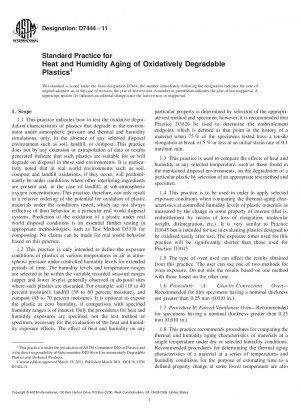ASTM D7444-11
Standard Practice for Heat and Humidity Aging of Oxidatively Degradable Plastics
- Standard No.
- ASTM D7444-11
- Release Date
- 2011
- Published By
- American Society for Testing and Materials (ASTM)
- Status
- Replace By
- ASTM D7444-18
- Latest
- ASTM D7444-18a
- Scope
Since the correlation between the conditions specified in this practice and actual disposal environments (for example, composting, soil or landfill) has not been determined or established, the test results are to be used only for comparative and ranking purposes in the laboratory. No extrapolation to real world disposal expectations or predictions are to be made from results obtained by this procedure. Real world evaluations and correlations are needed for such claims.
Degradable plastics exposed to heat and humidity are subject to many types of physical and chemical changes. The severity of the exposures in both time, temperature and humidity level, determines the extent and type of change that occurs. For example, short exposure times at elevated temperatures generally serve to shorten the induction period of oxidatively degradable plastics during which the depletion of antioxidants and stabilizers occurs. Physical properties, such as tensile and impact strength and elongation and modulus, sometimes change during this induction period; however, these changes are generally not due to molecular-weight degradation, but are merely a temperature-dependent response, such as increased crystallinity or loss of volatile material, or both. The effects of humidity are less well understood and are more difficult to predict and depend on the degradable plastics characteristics such as hydrophilicity, polarity and composition.
Generally, short exposures at elevated temperatures drive out volatiles such as moisture, solvents, or plasticizers; relieve molding stresses; advance the cure of thermosets; increase crystallinity; and cause some change in color of the plastic or coloring agent, or both. Normally, additional shrinkage is expected with a loss of volatiles or advance in polymerization.
Some plastic materials such as PVC become brittle due to loss of plasticizers or to molecular breakdown of the polymer. Polypropylene and its copolymers tend to become very brittle as molecular degradation occurs, whereas polyethylene tends to become soft and weak before it embrittles with resultant loss in tensile strength and elongation.
Embrittlement of a material is not necessarily commensurate with a decrease in molecular weight. Test Method is used to characterize any molecular-weight changes that are suspected to have occurred during thermal exposure.
The degree of change observed will depend on the property measured. Different properties do not change at the same rate. In most cases, ultimate properties, such as break strength or break elongation, are more sensitive to degradation than bulk properties such as modulus.
Effects of exposure can be quite variable, especially when samples are exposed for long intervals of time. Factors that affect the reproducibility of data are the degree of temperature control of the enclosure, humidity level of the oven, air velocity over the specimen, and exposure period which are evaluated by this practice. Errors in exposure are cumulative with time; for example certain materials have the potential to be degraded due to the influence of humidity rather than oxidation in long-term tests and thus give misleading results. Materials susceptible to hydrolysis (that is, hydrolytically degradable plastics) undergo degradation when subjected to long-term thermal tests due to the presence of moisture rather than oxidation.
Do not infer that comparative material ranking is undesirable or unworkable. On the contrary, this practice is designed to provide information that can be used for such comparative purposes after appropriate physical property tests are performed following exposure. However, since it does not account for the influence of stress or environment that is involved in most real life applications, the information obtained from this practice must be used cautiousl......
ASTM D7444-11 Referenced Document
- ASTM D1870
- ASTM D3045 Standard Practice for Heat Aging of Plastics Without Load
- ASTM D3593 Test Method for Molecular Weight Averages and Molecular Weight Distribution of Certain Polymers by Liquid Size-Exclusion Chromatography (Gel Permeation Chromatography GPC) Using Universal Calibration
- ASTM D3826 Standard Practice for Determining Degradation End Point in Degradable Polyethylene and Polypropylene Using a Tensile Test
- ASTM D5032 Standard Practice for Maintaining Constant Relative Humidity by Means of Aqueous Glycerin Solutions
- ASTM D5338 Standard Test Method for Determining Aerobic Biodegradation of Plastic Materials Under Controlled Composting Conditions
- ASTM D5510 Standard Practice for Heat Aging of Oxidatively Degradable Plastics
- ASTM D618 Standard Practice for Conditioning Plastics for Testing*, 2021-07-15 Update
- ASTM D6954 Standard Guide for Exposing and Testing Plastics that Degrade in the Environment by a Combination of Oxidation and Biodegradation*, 2024-01-01 Update
- ASTM D883 Standard Terminology Relating to Plastics*, 2024-02-01 Update
- ASTM E104 Standard Practice for Maintaining Constant Relative Humidity by Means of Aqueous Solutions
- ASTM E145 Standard Specification for Gravity-Convection And Forced-Ventilation Ovens
ASTM D7444-11 history
- 2018 ASTM D7444-18a Standard Practice for Heat and Humidity Aging of Oxidatively Degradable Plastics
- 2018 ASTM D7444-18 Standard Practice for Heat and Humidity Aging of Oxidatively Degradable Plastics
- 2011 ASTM D7444-11 Standard Practice for Heat and Humidity Aging of Oxidatively Degradable Plastics
